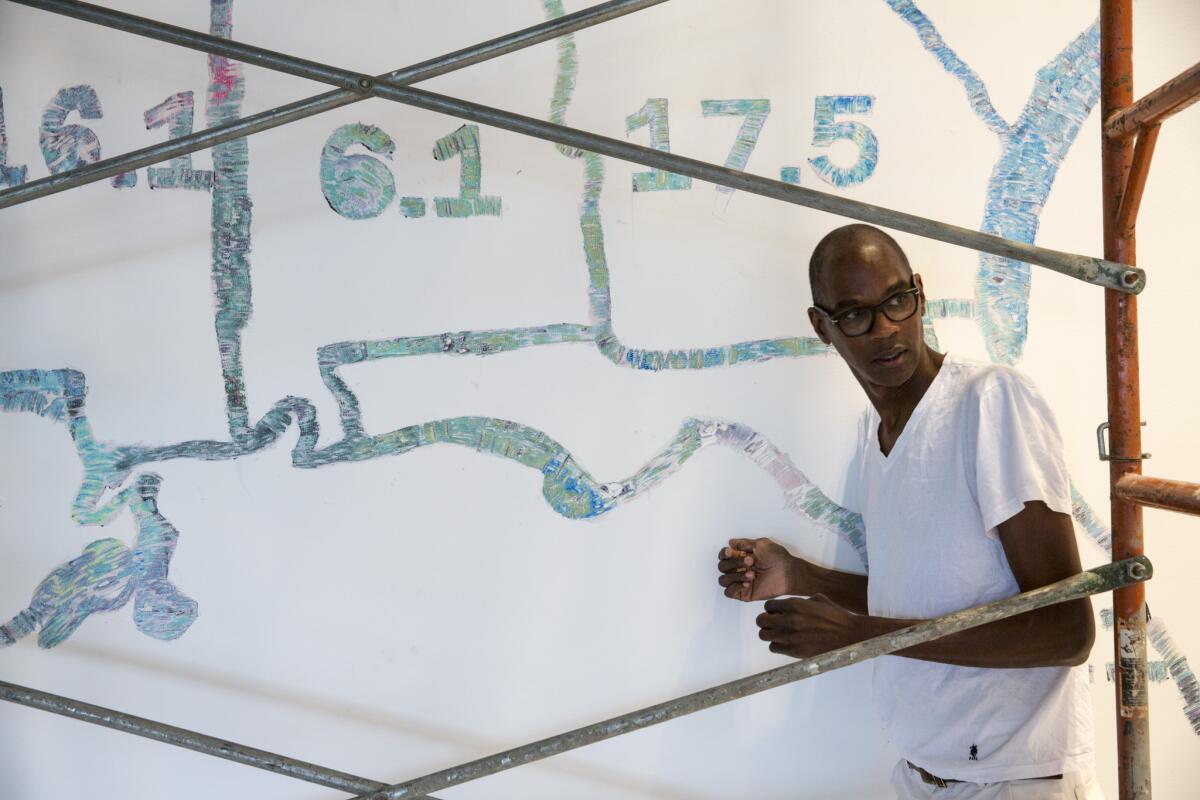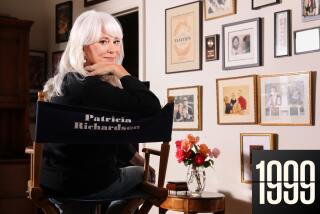Mark Bradford’s plans for 2017 Venice Biennale: ‘The whole of who I am and where I am now’

Los Angeles-born artist Mark Bradford, in front of his “Finding Barry, 2015,” at the Hammer Museum in Westwood.
Los Angeles artist Mark Bradford said Wednesday he has been given free rein in how he represents the United States at the 2017 Venice Biennale. The Rose Art Museum at Brandeis University, in cooperation with the U.S. State Department’s Bureau of Educational and Cultural Affairs, chose Bradford to create a site-specific installation for the U.S. Pavilion from May 13 to Nov. 26 next year at La Biennale di Venezia 57th International Art Exhibition.
Bradford said his plans are quite loose, but he added, “I’m really interested in both my social practice and my studio practice, so I’d like to create something that reflects the whole of who I am and where I am now.”
Bradford’s social practice is an arts education foundation based in Leimart Park called Art + Practice. It helps foster youth gain knowledge of — and experience in — contemporary art. Bradford doesn’t intend to bring A+P to Venice, but he said its model is something he’s exploring for export.
“I believe social impact engagement should be — and could be — replicated all over the world,” Bradford said.
Bradford’s international reputation is built on richly layered canvases that push the boundaries of class, culture, race and gender in order to explore the powerful undercurrents beneath the surface. He received his undergraduate and masters degrees from the California Institute of the Arts in Valencia and has staged solo shows at the Hammer Museum in Westwood, the Rose and the Whitney Museum of American Art, among others.
Right now, Bradford said, his mind is wrapped up in politics and what he describes as an Orwellian world. He expects political themes to be a part of his thinking as he works on the pavilion installation.
“The political infrastructure has really come to the foreground — the election, the voting the system. I as an artist find that interesting,” he said. “What we were and how we participated is really changing. Political and cultural ideas are laying on top of each other and colliding with each other right on CNN. It feels very visual to me — very material.”
Bradford’s exhibition at the U.S. Pavilion, opened in 1930 and managed by the Peggy Guggenheim Collection in Venice since 1986, will be the first Venice Biennale project presented by the Rose. It is commissioned and co-curated by museum director Christopher Bedford and curator Katy Siegel. The museum was selected on the strength of a proposal that it created with the help of Bradford.
When it comes to the Biennale, Bradford said his priority is to come across with a clear voice and a clear vision regarding where he stands as an artist and what interests him most.
“I don’t think any artist would ever become an artist if they thought about the baggage of art history. You find a way through all of that. You find a way to make it you,” Bradford said regarding the pressure of representing the United States at the Biennale. “As long as I think of history as something that moves, I don’t get freaked out about it. I think we have a tendency to think it’s written in stone, but if that were the case, civil rights and women’s issues would never move forward. Although slow, it does move. I’m just adding some history.”
Bradford went to Biennale for the first time a few years out of graduate school, “like every other young artist.” At the time he didn’t think of the pavilions as representing specific countries; instead he found them more representative of a particular artist’s work.
Either way, it’s the presentation of the living, breathing art of today that gives the Biennale its power and makes it relevant after all these years, Bradford said.
“I think contemporary ideas are always important and the more people can come in contact with contemporary ideas, which to me is the bedrock of what contemporary art is about, is always healthy for society,” he said. “I just think that people need to interact more with it.”
Twitter: @jessicagelt
More to Read
The biggest entertainment stories
Get our big stories about Hollywood, film, television, music, arts, culture and more right in your inbox as soon as they publish.
You may occasionally receive promotional content from the Los Angeles Times.











